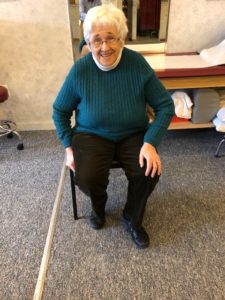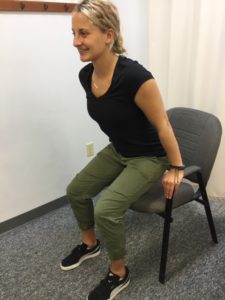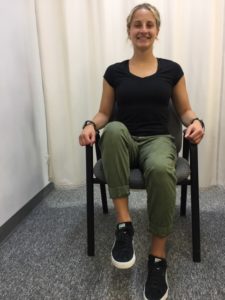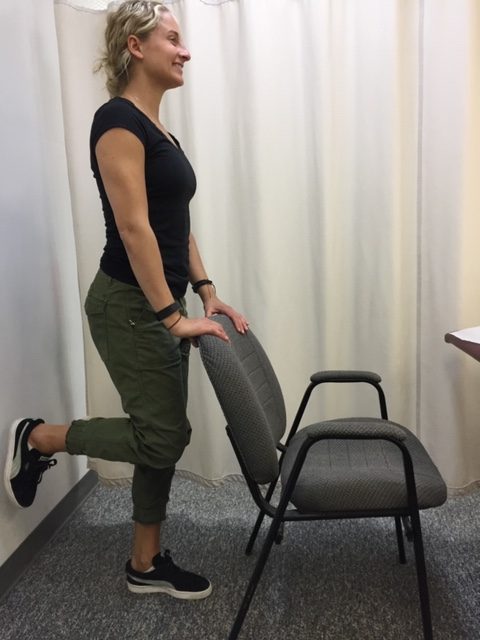
This column is written at the request of Kathryn Sarrides, an exceptionally spry senior who lives happily in Green Ridge with her sage husband, Harry. They, like many their age, work hard to maintain their independence by engaging in physical activity and exercise as well as intellectual stimulation by playing bridge, reading books and staying socially active. Last week, Kathryn came to me with a very common problem among octogenarians and nonagenarians… she was concerned about her safety getting out of a chair, especially a chair that did NOT HAVE ARMS!
Falls are a leading cause of injury and death in seniors. Thirty percent of women and thirteen percent of men over the age of sixty-five will fall. Twenty to thirty percent of these individuals suffer moderate to severe injuries. While preventing falls is not an easy task, there are a few things to consider that may go a long way!
The National Institute of Health (NIH) recommends four areas of concentration for elderly persons to concentrate on in order to maintain safety and independence: strength, flexibility, balance and endurance. It will be the purpose of this column to recommend safe and practical tips to get out of a chair and exercises to keep you strong and limber enough to do it safely.
1. Scoot Your Butt to the edge of the chair
2. Tip Your Trunk Forward – over your bent knees
3. Push Off the Arms of the Chair – while leaning forward
4. IF THE CHAIR HAS NO ARMS – Place one hand on the chair seat and the other hand on your knee. Then push up with your arms (SEE PHOTO A)
5. Push From your Legs – at the same time you push with your arms
6. Stay Still Standing – for a few seconds after You get up …before you walk

Strength Exercises involve using the muscles to move the arms and legs against resistance such as a weighted object, dumbbells, resistance bands, and body weight against gravity. Strength is necessary to perform daily activities such as: getting out of a chair, walking, lifting a half-gallon of milk, transferring to/from a shower safely.
These exercises are performed while sitting in a chair with backrest, slowly, 5 -10 repetitions, and 3-5 times per week. No weight is used in the beginning, only the weight of the arm against gravity. In 1-2 weeks a light 1-2 pound weight and light resistance band may be added.
Do these exercises while sitting in a chair with a backrest:
Chair Push-Ups – While sitting in a chair with arm rests, perform a push-up by pushing off the arms while pushing with your legs (PHOTO B)
Shoulder Shrug – shrug top of shoulders up toward the ears
Row the Boat – pull both arms back at a 45 degree angle with bent elbows as if “rowing a boat”
Elbow Bend/Extend – bend and straighten elbows

Do these exercises while sitting in a chair with a backrest:
Hip Hike – lift hip up 2-4 inches as if “marching” (PHOTO C)
Hip Spread – with heels on the floor, spread knees apart
Hip Squeeze – with heels on the floor, squeeze knees together
Leg Kicks – extend knee as if kicking the foot forward and up
Heel Raise – raise heel up with toe on floor
Toe Raise – raise toes up with heel on floor

Do these exercises while Standing. Always hold onto a counter top or the back of a stable chair:
Standing Leg Curl – facing and holding onto the countertop (chair), bend the knee by bringing the foot back (PHOTO D)
Standing Hip Hike - facing and holding onto the countertop (chair), hike hip up as if marching (PHOTO E)
Standing Squat – facing and holding onto the countertop (chair), bend both knees to a 20-30 degree angle. Hold this position for 5-10 seconds.
Once you have mastered these exercises against gravity, then advance to using light weights or light resistance bands. Ankle weights are very inexpensive and can be purchased in 1 pound increments. Light resistance bands are available in yellow and red in colors.
Visit your doctor regularly and listen to your body.
Keep moving, eat healthy foods, exercise regularly, and live long and well!


Read Dr. Mackarey’s "Health & Exercise Forum" every Monday in the Scranton Times-Tribune.
This article is not intended as a substitute for medical treatment. If you have questions related to your medical condition, please contact your family physician. For further inquires related to this topic email: drpmackarey@msn.com
Paul J. Mackarey PT, DHSc, OCS is a Doctor in Health Sciences specializing in orthopaedic and sports physical therapy. Dr. Mackarey is in private practice and is an associate professor of clinical medicine at Geisinger Commonwealth School of Medicine.